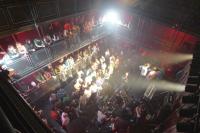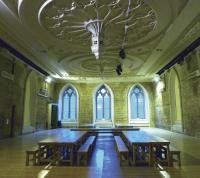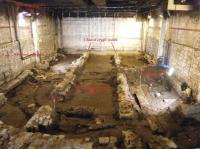The new Smock Alley Theatre
Published in 18th–19th - Century History, Cromwell, Early Modern History (1500–1700), Issue 5 (Sept/Oct 2012), Reviews, Volume 20
The ‘Boys’ School’ during a recent performance—one of three venues in a modern theatre in a late Georgian church built on the site of one of Ireland’s first theatres. (Kristian Marken)
Earlier in the summer the newly refurbished Smock Alley Theatre celebrated its reopening with a lively performance of Oliver Goldsmith’s She stoops to conquer, directed by Kristian Marken, the artistic director of the Smock Alley Players, although plays have been performed in the theatre for several years since it was reopened by Patrick Sutton, one of the people chiefly responsible for promoting the building of a modern theatre in a late Georgian church built on the site of one of Ireland’s first theatres. The history and importance of the site and its vicissitudes as a theatre make the decision to base the Gaiety School of Acting in Smock Alley and then to embark on a massive fund-raising project supported by both public funding and private philanthropy a really important event in Dublin theatre, with many exciting possibilities for the future. The development is also important for what it tells us about the state of the historic centre of Dublin and the possibilities of continuing the revitalisation of the inner city by ambitious and far-sighted cultural projects, which bring about a new lease of life for historic buildings and urban districts alike.
Smock Alley was the second theatre to open in seventeenth-century Dublin and, like its predecessor in Werburgh Street, it was closely associated with the viceregal court in Dublin Castle. Smock Alley’s beginnings in 1662 were a direct result of the Restoration monarchy’s reversal of the Cromwellian closure of the theatres under the Commonwealth. As so often, the theatre existed in a political and public context. This is something with which we are familiar from recent Irish history, and in particular from the central role of the theatre in the literary and cultural revival of the revolutionary period of the early twentieth century and later as a force for exploring—and, indeed, helping to create—the cultural identity conflicts of independent Ireland. The public role of the fledgling Irish theatre of the seventeenth and eighteenth centuries, though taking shape under radically different political and cultural conditions, was no less significant, and in some respects it was formative of some of the enduring characteristics of the development of Irish theatre.

The surviving stucco ceiling of the ‘Banquet Hall’ venue provides a clue to the quality of what was lost in the brutal removal of the 1813 interior of the former St Michael and St John’s Church to make way for a short-lived Viking interpretive centre. (Kristian Marken)
After its foundation by John Ogilby, who was master of the revels and therefore an extension of the culture of the viceregal court, Smock Alley Theatre developed as a stage for the performance of court-approved plays in the first instance, but in the course of the eighteenth century it also operated as the vehicle for the staging of a regular diet of plays from the London stage as well as a regular focus of politically inspired drama, which reflected the developing political culture of eighteenth-century Ireland. Thus in 1712 the politics of the Irish whigs were projected on the Smock Alley stage in eulogies for the late King William III at a time of Whig/Tory tensions in the city and country. On a number of occasions in the course of the eighteenth century the theatre was the scene of riots and disturbances, as in 1754, when a production of Voltaire’s Mahomet saw the theatre, then managed by Thomas Sheridan, convulsed by riots occasioned by the audience’s identification of the play’s speeches with the opposition politics of the Money Bill disputes of the 1750s. On this occasion Sheridan’s attempts to avoid identifying with the opposition led to the demolition of the interior of the theatre by an angry mob.
The role of Smock Alley, and its rivals and successors in Aungier Street and Crow Street, was also central to the development of a theatrical culture, as many of those, such as Farquhar, Goldsmith and O’Keeffe, who were to become established figures in the London theatre acquired their first experiences in Smock Alley. The provincial theatre in Ireland developed out of the touring circuits of the Dublin theatres and the eighteenth century saw the emergence of a brilliant succession of Irish actors and playwrights who went on to greatness in London. The symbiotic relationship between the theatrical cultures of the two countries was perhaps never stronger than in the heyday of Smock Alley. This is vividly recalled in the foyer of the new theatre by the large number of printed handbills on the walls detailing the regular presence in Dublin of leading figures from the London stage, such as David Garrick. A distinctively Irish theatre was rather slow to emerge from what was an essentially Anglocentric set of origins, but as it gradually did emerge in the late eighteenth century it owed much of its character to the formative role played by Smock Alley and its sister theatres.

The building in the course of excavation. Archaeologist Linzi Simpson discovered the floor plan of the original 1662 theatre and also of the rebuilt theatre dating from 1735. Note the horseshoe-shaped auditorium consisting of stalls and tiers of galleries and boxes. (Linzi Simpson)
The present theatre occupies the same footprint as the original. Excavations of the site were conducted by Linzi Simpson, who has also worked extensively on the Dublin city walls in this area. Simpson discovered the floor plan of the original 1662 theatre and also of the rebuilt theatre dating from 1735, for which we also possess a stage plan, consisting of a proscenium, an arched stage and a horseshoe-shaped auditorium consisting of stalls and tiers of galleries and boxes. Simpson’s excavations revealed remains of mosaic floors as well as oyster shells and clay pipes left by the eighteenth-century audiences, and even an actress’s wig-curler. In many ways these discoveries add to the excitement of the new theatre built on the same foundations as the old but with a radically new layout.
The new developments also make up for some of the mistakes of the recent past, when the Temple Bar authority sanctioned a brutal removal of the 1813 interior of the former St Michael and St John’s Church, which ultimately replaced the original theatre. A black-box exhibition space and a short-lived Viking interpretive centre occupied what had been an unusually fine example of late Georgian Gothic Revival architecture. A clue to the quality of what was lost can be seen in the surviving stucco ceiling of the church. Perhaps the new Smock Alley can atone for this act of vandalism, particularly if it continues to stage new productions of eighteenth-century classics in lively modern productions such as the recent She stoops to conquer. HI
Eamon O’Flaherty lectures in history at University College Dublin.
















